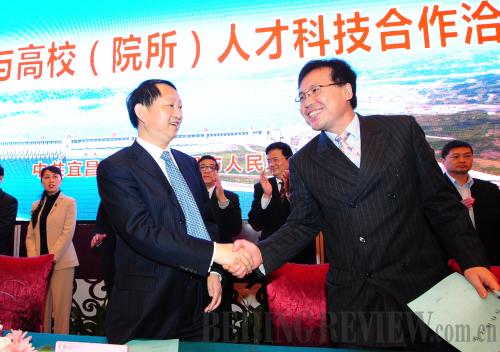|
 |
|
WIN-WIN COOPERATION: Wang Feibo (right), a Canadian national, signs a contract on April 17, 2011 with a hi-tech park in Yichang, central China's Hubei Province, to make slurry ice generators using his patented technology (CHENG MIN) |
Dong Wei, a professor at the Design Studies Department of University of Wisconsin-Madison, splits his time evenly between the United States and China. He spends his time in the United States lecturing students in design visualization and Asian design, and during his stay in China he travels around the country to study the nearly vanished buildings of minority ethnic groups and traditional courtyard and cave houses.
"As one of the overseas returnees working in China, I enjoy my lifestyle as a 'seagull,'" Dong told the People's Daily. Dong, who left China for the United States to further his studies in the 1980s, believes that constantly being exposed to different cultures is the best way to fuel his creativity.
As more and more overseas Chinese are willing to come back and work in China, there has been an increase of "seagulls," a term coined to refer to "half-returnees" who split their time between China and other countries. This group of privileged returnees are mostly top scientists and engineers, senior managing staff in multinational corporations and banks and entrepreneurs who have developed their own patents or technology.
The China News Service reports that there are more than 100,000 "seagulls" regularly migrating between China and abroad, and the population is growing rapidly.
Xiao Tu (a pseudonym) studied in Japan for five years for a doctoral degree in cancer studies. She came back to China in 2009 and found a job as a senior research fellow at a research institute under the Chinese Academy of Sciences. Having recently quit her job, she plans to work in the United States.
"Since the world's most advanced research in cancer is being conducted in the United States, I expect to be better positioned to transfer what I have learned into tangible products and achieve a more successful career there," she said.
The mother of a young daughter also admitted that her new career plan will put strain on her family, as her husband will continue to work in China and her daughter will have to stay with her grandparents. "I promised them that the separation would not be long as I would find a long-term development path within three years," she said. For the near future, she said that she would have to fly between China and the United States frequently.
Nanfang Daily published in Guangzhou, southern Guangdong Province, reported that a lot of "seagulls" are entrepreneurs who have set up their companies in a foreign country and are making a fortune helping Chinese companies in similar fields to find foreign clients. Another group of them are simply selling information or services to Chinese companies or individuals, such as the owners of many immigration agencies based in China. According to the report, most "seagulls" not only have foreign education backgrounds, but also the ability to discover the cultural and social differences between East and West as well as the ability to spot business opportunities.
In recent years, the Chinese Government has come up with proactive measures to attract global talent, including overseas Chinese and those of non-Chinese origin.
In December 2008, the Chinese Government launched the Recruitment Program of Global Experts, which was designed to recruit 2,000 talented people of any nationality over the next five to 10 years. Compared with earlier programs such as the Chinese Academy of Sciences' 100-talent scheme and the Ministry of Education's Yangtze River Scholar Scheme, both of which were initiated in the 1990s to attract the world's top scientists and academics, the new scheme not only sets the bar higher, but also casts a wider net. It aims to attract three groups of top-class minds: those with an academic title equivalent to professor in internationally well-known universities and institutions, senior executives within well-known international companies or banking institutions, or entrepreneurs who have developed technologies and patents and established their own businesses abroad.
|
